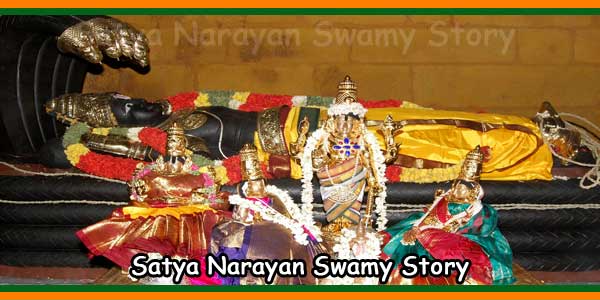Satya Narayan is the Narayan form of Lord Vishnu. The Lord in this form is considered an embodiment of truth. Satyanarayana is worshipped commonly by Hindus in their homes with family and friends, usually on a full moon (purnima) day of the month. In this puja called Satyanarayana Pooja, people worship by reciting the gracious story of Lord Satyanarayana. This story was originally told by Lord Vishnu himself to the sage Narada for the benefit of humankind.
This puja is conducted to ensure abundance in ones life. Many people carry out this puja immediately after or along with an auspicious occasion like a marriage or moving into a new house or any other success in life. The satyanarayan puja can be performed on any day. It is not a puja confined to any festivities. But Poornima (full moon day) or Sankranti are considered to be most auspicious day for this puja. Performing this puja in the evening is considered more appropriate. On the day of the puja, the devotee has to fast.

The vrata is explained in five chapters. The first or the introductory chapter deals with the timing of the vrata and the procedure to go about it. The remaining four chapters contain three stories to reassert the greatness and benevolence of the Almighty. The stories weave out such anecdotes, which reveal the significance of the vrata quite effectively. The vrata is also revealed in nine chapters in some books.
On the day of the vrata, it is required to fast and perform the pooja towards the evening. In a sacred pooja room, a new cloth has to be spread on an elevated platform. Rice about a Kg is to be spread on the cloth and in the centre and a kalash capped with a new cloth piece should be placed and on that the token or a small idol of the Lord has to be positioned. A Panchamruta (a mixture of ghee, milk, sugar, honey and curds) abhishekam has to be performed.
Vrata begins with the lighting of the lamp, a symbolic gesture of lighting the lamp of devotion in one’s heart. Then we pray to Lord Ganesha, the dispeller of obstacles, Lakshmi, the giver of prosperity, Vishnu, the sustainer, Lord Shiva and Parvathi, the primordial couple who dance their way to cosmic rhythm, Sun God, the giver of good health, the nine planets and Ashtadikpaalakas including Lord Indra.
Lord Ganesha and Panchaloka Paalakaas should be positioned to the north of the Kalasha and can be worshipped through areca nuts or almonds or turmeric pods or dry dates. Later, the nine planets should be worshipped by placing areca nuts on betel leaves followed by Lord Indra and other Dikpaalakaas. Later the Lord Satyanarayana’s idol or image on betel leaf should be worshipped through panchamruta abhisheka. The pooja runs in ashtottara or satanaama attributes and culminates with haarathi and taamboolam. At the end of the vrata there is udvaasana, a formal way of concluding the pooja. The vrata can be performed by every devout individual by inviting brahmins, friends and relatives. The underlying spirit is to bring in as many people as possible into the divine cult.
Pooja Materials:
A book on the vrata (It is preferable to seek help of a purohit), a square platform, mango leaves, two new cloth pieces, kalasha, lord’s idol or a photograph, turmeric, kumkum, panchamruta, six coconuts, prasada, four oil lamps, sandal paste, incense sticks, betel leaves, two garlands, areca nuts, turmeric pods, dry dates or almonds, camphor, offerings in form of cash or coins, tulsi leaves and flowers.
